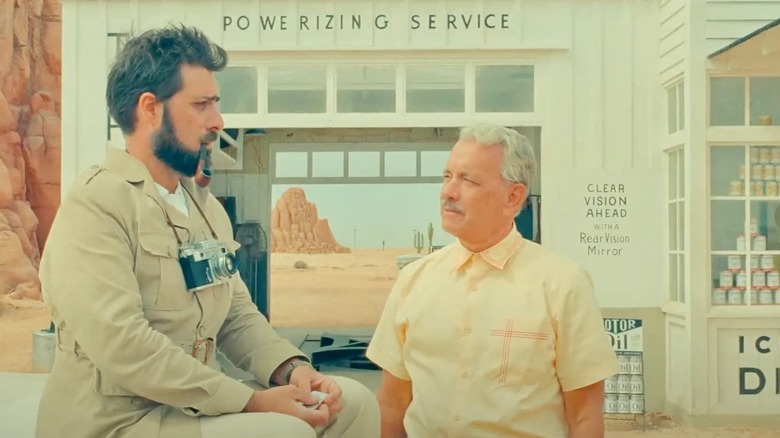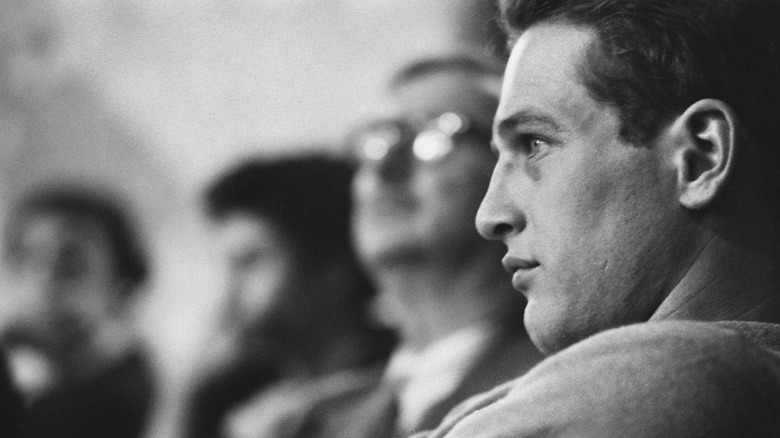Wes Anderson Wanted Asteroid City To Unite New York Theater And Hollywood Cinema
The characters of Wes Anderson's "Asteroid City" might have their gazes cast skyward, but Anderson's inspiration for his 11th feature was decidedly grounded.
The film — which boasts a star-studded cast from his regular acting company, including Jason Schwartzman, Willem Dafoe, Tilda Swinton, Edward Norton, as well as first-time collaborators like Tom Hanks, Steve Carell, Margot Robbie and Hope Davis — blends Anderson's twin loves of cinema and theater. There has always been a stage-friendly quality to the filmmaker's movies — not "stagey," which would suggest a visual listlessness, but a kind of proscenium framing that shows off his lovingly arranged mise en scène.
But it's not just an aesthetic consideration. Dating back to his marvelous sophomore effort, "Rushmore," Anderson's fervent love for the boards reminds us of the endless possibilities within the seeming limits of a theatrical production. The character Max Fischer has a "let's-put-on-a-show" bravado that powerfully evokes a childhood yearning to entertain one's family and friends. Fischer and his players might take that enthusiasm to startlingly naturalistic extremes, but — as someone who grew up doing theater and earned a perfectly useless BFA in the craft — his productions of "Serpico" and the "Apocalypse Now"-inspired "Heaven in Hell" hit me as wish fulfillment. I wish I'd possessed that kind of pluck and resourcefulness at that age.
Anderson is essentially Fischer-made-good in that he gets to build richly imagined sets and populate them with some of the biggest stars in the world. So it's interesting to find the 54-year-old filmmaker using his latest to reflect on his ardor for a bygone era of artistry that's fired his entire career.
Paul Newman visits Asteroid City (in spirit)
In a May 2023 interview with El País, Wes Anderson was asked about the "disparate ideas" that inform the pop-up setting of "Asteroid City." It's a collision of outmoded concepts (the automat diner) and creative movements (the Actors Studio-driven glory days of New York City theater). Here's how Anderson explained it:
"We had an idea that we wanted to do a '50s setting and it's got these two sides. One is New York theater. There's a picture of Paul Newman sitting with a T-shirt on and a foot on the chair in the Actors Studio. It was about that world of summer stock, behind the scenes of that, and these towns that were built and never moved into. That becomes the East Coast and the West Coast and the theater and the cinema. There's a series of dichotomies."
It's natural for people to feel nostalgia for eras that predate their existence. By the time I was born, Actors Studio wunderkinds like Newman, Marlon Brando, Marilyn Monroe, Anne Bancroft, Al Pacino, and Jack Nicholson had fled the stage for big-screen stardom. Automats? Never set foot in one. Though I certainly don't pine for the bigotry and anti-intellectualism of the time (then again, it's not like things are that much different on that front today), I can't help but feel wistful for a bygone era if only because today, I can't experience the unimaginable joy of getting to see Brando play Stanley Kowalski on a Broadway stage in Tennessee Williams' "A Streetcar Named Desire."
But Anderson's inspiration for "Asteroid City" wasn't limited to '50s theater. Indeed, the film's Western trappings pay aesthetic homage to a titan of 1970s playwriting.
Anderson goes west and finds Sam Shepard
Speaking with The Daily Beast this month, Wes Anderson revealed that his screenplay, which he co-wrote with frequent collaborator Roman Coppola, was an affectionate nod to playwright-actor Sam Shepard. "The name that was in our minds was Sam Shepard," he said. "We were thinking about something kind of Sam Shepard, out in the West somewhere. Then it swirled together and became this '50s thing."
That's an extremely specific point of reference. Shepard's best work — "Buried Child," "True West" and "Fool for Love" — are emotionally supercharged dramas about perversely broken families and people. Anderson has certainly explored similar dynamics, but his films tend to simmer whereas Shepard's plays boil. Still, it's heartening to know — and perhaps instructive to the haters — that Anderson isn't working from the fenced-in, repetitive worldview of an upper-class Texan. This should be obvious from the diverse concerns of his films, but some people can't see past the style.
Anderson's movies aren't for everyone, but, as these two interviews prove, you can't write him off as an incurious dullard. Twenty-eight years into his career, he is still seeking, still feeling, and still churning out cinema that only Wes Anderson can make.


